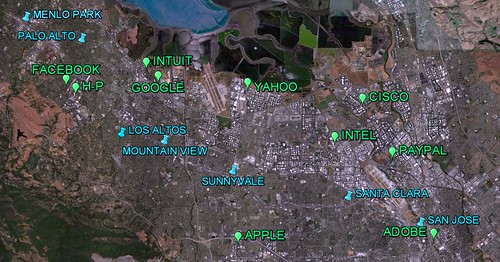Official review finds environmental benefits from additional homes near Silicon Valley jobs

Posted December 15, 2011 at 2:01PM
California’s Silicon Valley is notoriously jobs-rich and housing-poor. There has been a particularly severe shortage of affordable housing, forcing workers employed in communities such as Mountain View, Los Altos, Sunnyvale, and Santa Clara to live far from their workplaces, driving long distances through severe traffic congestion just to do their jobs. A detailed 2007 report developed by The Institute for Metropolitan Studies at San Jose State University found that Silicon Valley would need 90,000 new units of affordable housing over the next 20 years to meet growing demand.
This has been a drain on the region’s economy, and also a source of significant environmental damage. Because an insufficient number of homes have been built within existing Valley communities, the region’s housing supply has taken the form of low-density suburban sprawl in far outlying areas, eating up the California landscape while mandating lengthy car trips that increase emissions of carbon dioxide and other air pollutants.
Ironically, though, the mechanisms built into environmental law can sometimes stand in the way of smart growth solutions to these issues. The California Environmental Quality Act (CEQA), in particular, is an important law that is strongly supported by my organization, NRDC, and that has prevented much environmental damage. B ut it can be misapplied: if the impacts of building additional affordable homes are compared only with not building them, a strict application of the law’s analytical requirements can result in a finding of environmental damage.
ut it can be misapplied: if the impacts of building additional affordable homes are compared only with not building them, a strict application of the law’s analytical requirements can result in a finding of environmental damage.
However, that is frequently not the choice we face in the real world, where worker housing must be built somewhere, and the current pattern of housing development is causing environmental harm. The more pertinent question is which housing choices will do the most to reduce that harm. And, generally speaking, we know from experience and a vast amount of research that building walkable neighborhoods with an efficient footprint on the land – condos, apartments, townhouses, and small-to-moderately-sized lots of single-family homes, on close-in sites – are best for the environment. They also help the economy, by reducing household transportation costs and government infrastructure costs.
That’s why a new analysis under CEQA by the Silicon Valley city of Mountain View, home to Google and other major high-tech employers, is so important. In examining the city’s new General Plan, Mountain View asked the right questions and reached a realistic conclusion: the environment will be better off with more, not less, housing within the existing city’s footprint. Greenbelt Alliance, the San Francisco Bay Area’s leading conservation group, explains:
“The draft Environmental Impact Report for the City’s General Plan, one of three important planning documents released on November 30, finds that planning for more homes in Mountain View is the ‘environmentally superior alternative.’ LSA Associates, who completed the draft report for the City, explains that the decrease in environmental impacts is due to the reduction of per capita vehicle miles traveled (VMT). Simply put, this means people will drive less if there are more homes in Mountain View . . .
“Greenbelt Alliance is thrilled that Mountain View staff found that adding more homes would create real village centers that encourage people to drive less to jobs or stores. We hope that . . . investigating an ‘Increased Housing Alternative,’ to speak in planner-ese, will become standard operating procedure for Bay Area cities.”
While this may strike anyone who is familiar with the impacts of land use patterns on transportation and emissions as common sense, it is not as common as it should be for environmental impact analyses to examine candidly the benefits of building more homes within easier reach of jobs. Mountain View is to be commended for being realistic. Given that between 50 and 60 percent of the city’s greenhouse gas emissions (nearly 500,000 metric tons of CO2 per year) are generated by transportation, realism seems like an idea whose time has come.
Move your cursor over the images for credit information.
